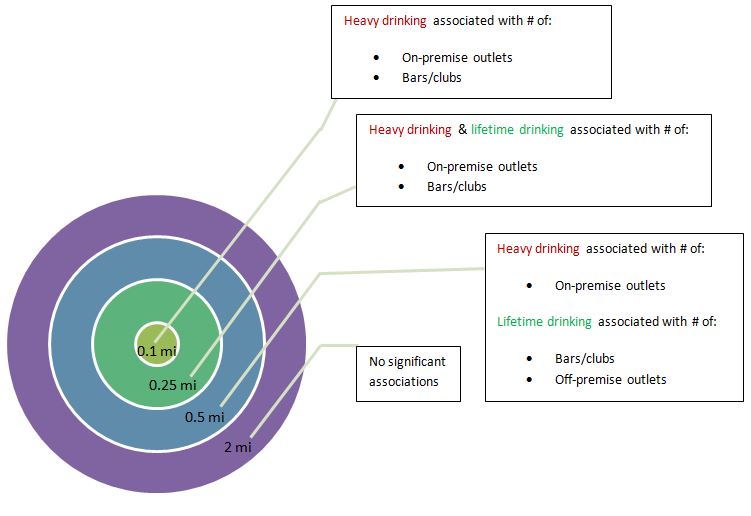Adolescents Growing Up in Neighborhoods with More Liquor Stores are More Likely to Drink
Alcohol use among adolescents is a major public health concern as early initiation of alcohol is associated with future problems such as alcohol use disorder, alcohol-related violence, and use of other substances.
WHAT PROBLEM DOES THIS STUDY ADDRESS?
With one third of 8th graders in the U.S. reporting alcohol use, it is important to determine methods for delaying alcohol initiation.
This study examined the association between neighborhood alcohol availability and adolescent alcohol use. If the data suggests living in an area with high density of alcohol outlets translates into increased likelihood of any drinking or hazardous drinking among adolescents, policy changes such as laws limiting the number of alcohol outlets in an area may be needed to address this issue.
HOW WAS THIS STUDY CONDUCTED?
Data on participants (n = 2724) were obtained from a study of middle school students (7th, 8th, and 9thgraders) from 16 schools in southern California. Alcohol outlet data was obtained from the California Department of Alcoholic Beverage Control database. This study made the distinction between alcohol outlet type by examining off-premise outlets (i.e., establishments such as liquor stores where alcohol is sold for off-premise use), on-premise outlets (i.e., establishments such as restaurants and hotels where alcohol is purchased and consumed on-premise), and on-premise outlets where minors are not allowed (hereafter referred to as bars/clubs).
Alcohol availability was determined by the number of alcohol outlets within a certain mile radius from each participant’s home. The authors used four zones with radii of 0.1 miles, 0.25 miles, 0.5 miles, and 2 miles which is important for determining what sized region is relevant for this age group. For example, an adolescent with access to a car may be more likely to drive 2 miles to obtain alcohol to avoid being seen within their own neighborhood while younger adolescents who rely on walking may stay within a 0.5 mile radius.
The outcomes of the study were heavy drinking, defined as 5 or more drinks in a “short period of time” (e.g., 2 hours) in the past month, and lifetime drinking, defined as drinking at some point in the past but not currently (i.e., no alcohol use in the past 30 days). This measure of lifetime drinking was chosen so that it excluded heavy drinkers.
Lastly, the authors used statistical methods to adjust for potential confounding of the effect of alcohol density on adolescent drinking. These variables included gender, age, race/ethnicity, father’s educational attainment (a measure of individual-level socioeconomic status), and neighborhood-level socioeconomic status.
WHAT DID THIS STUDY FIND?
Participants were 46% male, 50% Hispanic, and 14 years old on average (range: 10-16 years). Almost one quarter reported lifetime drinking and about 5% reported at least one heavy drinking episode in the past 30 days.
For on-premise outlets, a higher number of outlets within a 0.1mile, 0.25 mile, and 0.5 mile radius was significantly associated with higher odds of heavy drinking. The odds ratios [ORs] were 1.26, 1.05, and 1.01, respectively. This can be interpreted, for example, as a 26% increase in the odds of being a heavy drinker for each additional alcohol outlet within 0.1 miles. The number of outlets within a 0.25 mile radius was also significantly associated with lifetime drinking (OR: 1.03).
For bars/clubs, number of outlets within a 0.25 mile radius was significantly associated with both heavy (OR: 1.20) and lifetime drinking (OR: 1.15). Heavy drinking was also associated with alcohol availability within 0.1 miles (OR: 1.92) and lifetime drinking was associated with availability within 0.5 miles (OR: 1.06).
For off-premise outlets, alcohol availability within a 0.5 mile radius was associated with higher odds of lifetime drinking only (OR: 1.03).

This study has important policy-level implications. Overall, greater alcohol density was associated with both heavy and lifetime drinking among adolescents. Importantly, on-premise outlet density was consistently associated with heavy drinking for the smaller buffers ranging from 0.1 to 0.5 miles.
Bars/clubs (i.e., on-premise outlets that did not allow minors) were also associated with heavy drinking in the two smaller geographic ranges. Regardless of geographic range, there was no association between heavy drinking and off-premise outlets. This study suggests that on-premise outlets (of both types) in close proximity to adolescents’ homes could be targeted when trying to prevent heavy drinking among youths.
WHY IS THIS STUDY IMPORTANT
Passive interventions such as stricter laws are among the best public health approaches to curb drinking as they provide automatic protection with no action required from the individual.
However, the evidence is currently mixed so it is difficult to rationalize this approach for the purpose of preventing youths’ exposure to alcohol.
Study results are consistent with two other U.S. studies on alcohol outlet density (see here and here) that also compared on and off premise alcohol outlets. Additionally, the estimates from this study are independent of neighborhood-level socioeconomic status (i.e., poverty level in a neighborhood) which strengthens the support for this association between on-premise outlets and alcohol use among youths.
This association did not differ by gender, age, or race which indicates that prevention efforts are necessary for all youth. Research has shown that perceived neighborhood safety can be an impact factor in substance use disorder recovery. This suggests that neighborhood/community characteristics can influence recovery outcomes as well.
- LIMITATIONS
-
- Possible variables associated with adolescent alcohol consumption that were not adjusted for in this study but could potentially impact results include alcohol advertisements, peer influence, and parental approval.
- Since this study is cross-sectional, all associations should be interpreted as correlational rather than causal. In other words, this study does not show that living near an alcohol outlet necessarily causes an adolescent to drink.
NEXT STEPS
Future research on proximity to alcohol outlets should also incorporate factors such as the impact of alcohol advertisements on youth and the influence of peers and parents to obtain a complete picture of what drives adolescents to begin drinking and/or drink heavily.
BOTTOM LINE
- For individuals & families seeking recovery: If you live in a neighborhood with a lot of places that serve alcohol on-site (restaurants, bars, clubs, etc.), this may be a risky environment for youths & teens, as it is associated with a greater likelihood of drinking.
- For scientists: Controlling for neighborhood-level factors in analyses is important for studies that seek to understand how environmental factors may impact the individual. For this particular study, controlling for neighborhood-level socioeconomic status provides more confidence that the observed associations between alcohol-outlet density and adolescent alcohol consumption are true.
- For policy makers: On-premise alcohol outlet density, including establishments that did not permit minors, was associated with heavy and lifetime drinking among adolescents. Stricter enforcement of alcohol-related laws or limiting the number of these outlets in residential neighborhoods may have a widespread benefit for youths.
- For treatment professionals and treatment systems: This article is not related to treatment but has important implications for preventing alcohol consumption among young adolescents. For treated adolescents with an alcohol use disorder, however, living in an area with higher alcohol outlet density could present an additional relapse risk factor beyond individual level factors, but this awaits further investigation.
CITATIONS
Shih, R. A., Mullins, L., Ewing, B. A., Miyashiro, L., Tucker, J. S., Pedersen, E. R., . . . D’Amico, E. J. (2015). Associations between neighborhood alcohol availability and young adolescent alcohol use. Psychol Addict Behav, 29(4), 950-959. doi:10.1037/adb0000081

